How to get to grips with complex reporting
Understanding all the terminology in digital marketing can be overwhelming, especially if you’re new to it all. When it comes to 3rd party data, metrics, KPIs and reporting, what exactly does it all mean?
Don’t worry, you’re not the first person to wonder and you certainly won’t be the last. That’s why we’re giving you this easy-to-digest guide on some need-to-know digital marketing terminology. Let’s dive a little deeper into what these terms mean, why you need to know them and how they can guide and transform your digital marketing using data-driven insights.
What is a KPI?
KPI stands for key performance indicator. It’s a quantifiable value lots of marketers use to set and track goals. KPIs are usually the driving factor when it comes to campaign success and can help your business to make better-informed decisions in terms of budgets and strategies. Here are some of the most popular types of KPIs used by digital marketers:
- Revenue growth
- Profit margin
- Client retention rate
- Customer satisfaction
- Revenue per client
Key takeaway: Decide which KPIs are most suited to your business, and the marketing activities you’re using to drive growth.
What are digital marketing metrics?
Metrics are a form of measurement that are tied to specific objectives. They are the measurable actions that are associated with a KPI. Whereas KPIs offer a top-level view – metrics indicate the performance of activities which sit underneath an overarching KPI. Some common metrics include:
- Social media likes, shares and or comments
- Organic and or paid traffic
- Website domain authority
- Backlinks
- Conversions
- CPCs
Key takeaway: Agree on a clear set of metrics thatwill help you gain a clear understanding of how different marketing activities are helping you reach your KPIs.
What is third party data?
Third-party data is any information collected by an entity (a business or organisation, that does not have a direct relationship with the person the data is being collected on. This can include data sets that are meshed together from various sources or which may come from governmental, sources (e.g. weather data, public demographic data, social media data) Understanding the rules around gathering and using 3rd party data is key to being a successful marketer.
Plus, with Google removing third-party cookies, using trustworthy, reliable data is proving tricky for retailers. While this is good news for people’s privacy online, it does threaten the future of targeted ads. Luckily, there is still time for marketers to make the necessary changes to adapt to this update. For example, BOSCO™ uses trusted third-party data that is GDPR compliant and doesn’t track user behaviours to put your mind at ease.
Key takeaway: Use trusted platforms, like BOSCO™, to adapt to new 3rd party rules and have peace of mind.
What is reporting?
Marketing reports are documents used to collate KPIs and marketing performance and lay them out in a visual way that is easy to understand. Most marketers will produce reports once every month across multiple channels and disciplines. Reports should give a clear picture of performance and progress.
For online retail marketers with campaigns running across multiple channels and media platforms, reporting can be a complex process. Finding smart ways to streamline reporting time and reduce the human error in collating it is key.
Key takeaway: Find a trustworthy reporting platform which helps gather insights across your marketing channels and campaigns, for one version of the truth.
How to use data, metrics and KPIs to guide reporting
Having a holistic view across all four areas can prove tricky, especially when it comes to interpreting success. That’s why using a digital marketing platform, like BOSCO™, can help you view cross-channel data and understand your online activity on a much deeper level.
Without a reporting and dashboarding tool, companies can waste hours, if not days, on reporting. That includes exporting and displaying data in a clear way. With BOSCO™, all the leg work is done for you. Machine learning pulls your data from across multiple channels to generate one clear source of truth in an easy-to-digest report. Monthly, weekly, daily – whatever you need, when you need it.
With this overview of digital marketing performance, you can strategise, evaluate and plan future campaigns and even use the forecasting tool to experiment with hypothetical budget spends.
Get smart with your digital marketing reporting
If you’d like to streamline your reporting, save tonnes of time and have a clear view of digital marketing performance, book a 15-minute demo with one of the BOSCO™ Team. Or drop us an email if you’d like to receive more digital marketing insights like these.




